Table of Contents
Composite decking has emerged as a favored option for homeowners desiring both durability and aesthetic appeal in their outdoor environments. To maintain its pristine condition, it is essential to comprehend both the benefits and potential drawbacks associated with this material. This article will provide an exploration of what composite decking is, its advantages and disadvantages, as well as the most effective methods for ensuring its cleanliness. For those who have considered pressure washing their composite deck, this article will address safety concerns, provide a step-by-step guide, and present alternative cleaning options to help maintain the deck's appearance.

Composite decking is a modern alternative to traditional wood decking, made from a blend of recycled wood fibers and plastic, resulting in durable and low-maintenance decking boards.
This innovative decking material is designed to resist mold, rot, and insect damage while providing a moisture barrier that helps maintain its integrity over time.
Popular brands like Trex and TimberTech, as well as Keystone Custom Decks, offer various styles and colors, making it an attractive option for homeowners looking to enhance their outdoor spaces without the extensive maintenance wood requires.
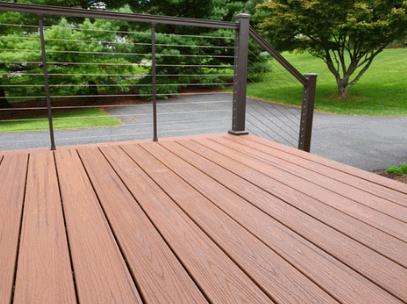
Composite decking offers numerous benefits that make it a popular choice among homeowners, including its low maintenance requirements, resistance to mold and mildew, and a long-lasting warranty that often includes a stain warranty.
Unlike traditional wood, composite materials do not need regular staining or sealing, saving time and money over the lifespan of the deck. This durability makes it an excellent option for those who want to enjoy their outdoor space without the hassle of frequent upkeep, while also being available in various styles and compatible with a range of deck accessories for enhanced deck care.
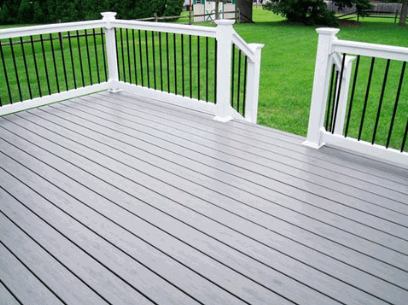
While composite decking has numerous advantages, it also comes with certain drawbacks that potential buyers should consider, such as a higher initial cost compared to traditional wood, heat retention issues, and the possibility of fading over time.
Homeowners may find that the investment in composite materials pays off in durability and maintenance savings, yet the upfront price can be a barrier for some. However, brands like Trex and TimberTech offer financing options to mitigate the higher initial costs.
Additionally, while composite decks resist mold, they can still develop mold stains if not properly cleaned, which is why regular maintenance is essential. Using an oxygenated cleaner such as sodium percarbonate or UltraBan can effectively remove mold stains without causing damage.

Pressure washing is a cleaning method that utilizes a high-pressure water spray to remove dirt, grime, mold, and other contaminants from various surfaces, including driveways, sidewalks, and decks. This technique is particularly effective for deck maintenance, as it can rejuvenate the surface of composite decking and wooden decks alike when performed correctly.
By using a suitable cleaning solution and maintaining the maximum PSI recommended for the decking material, homeowners can ensure a thorough clean without damaging their outdoor spaces.
Explore further: How To Clean External Cladding
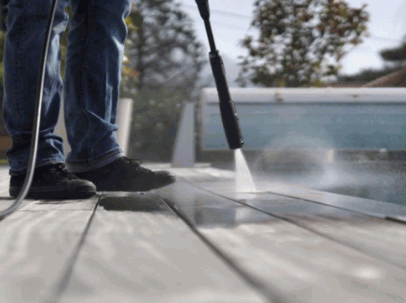
Yes, you can pressure wash composite decking as part of your deck maintenance routine, but it’s crucial to follow proper guidelines to avoid damaging the surface. Using a pressure washer with adjustable settings allows homeowners to select the appropriate maximum PSI that is safe for composite materials, ensuring effective cleaning without stripping away protective coatings. Incorporating cleaning solutions specifically designed for composite decking can help remove stubborn stains, enhancing the overall appearance of your outdoor space.
To ensure a thorough yet safe cleaning process, it is recommended that the pressure washer is set to a maximum of 1200 PSI. Going higher than this can potentially lead to surface damage, which compromises both aesthetics and longevity.
Selecting the right cleaning solution is crucial; look for products that are biodegradable and specifically formulated for composite surfaces.
Regular pressure washing not only enhances the deck's appeal but also plays a vital role in maintaining its integrity and preventing issues like deck rot.
Proper care through periodic cleaning is essential to prevent mold and mildew buildup, which can lead to substantial damage over time. Keeping up with this maintenance routine, including using a soft bristle brush and a suitable cleaning solution, can significantly extend the lifespan of your composite decking.

Pressure washing composite decking can be effective, but it also carries certain risks that homeowners need to be aware of, including potential damage to the decking surface and the risk of mold stains if not done correctly. High-pressure settings can strip away the protective coatings that guard against moisture and UV damage, leading to quicker wear and tear. Therefore, it is essential to use the right pressure and techniques to avoid these issues and ensure the longevity of your composite deck.
When homeowners consider pressure washing composite decking,
to the deck's surface. If the pressure is too high, it can create grooves in composite materials or remove the surface layer, leading to premature deterioration and potential health hazards from mold growth.
To mitigate these risks, individuals should follow best practices: begin with a lower pressure setting.
Emphasizing these preventive measures will not only protect the aesthetic appeal but also extend the life of your composite decking.
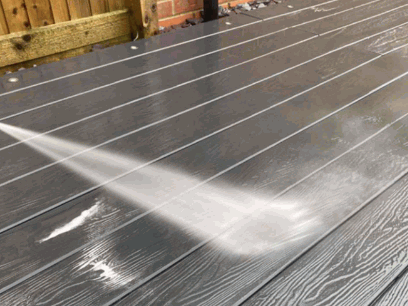
To safely pressure wash composite decking, homeowners should follow a series of steps that ensure cleaning effectiveness while protecting the integrity of the decking material.
Start by gathering the necessary tools, including a pressure washer with the appropriate settings, a soft bristle brush for scrubbing stubborn stains, and a suitable cleaning solution. Proper preparation and technique are key to achieving a clean deck without causing damage, making it vital to adhere to recommended practices throughout the process.
Preparing the deck before pressure washing is crucial to ensure an effective cleaning process and protect the composite material’s moisture barrier from potential damage. Start by removing all furniture, planters, and other items from the deck surface, allowing for unobstructed access. It's also important to sweep away any loose debris, leaves, or dirt that may interfere with the cleaning process, setting the stage for a thorough wash and reducing the risk of mold stains.
After clearing the surface, it’s essential to inspect the deck for any signs of damage or wear, such as deck rot, as this can affect the cleaning outcome. Take the time to check for loose boards, protruding nails, or other hazards that could cause issues during the pressure washing.
This kind of meticulous attention to detail ensures the longevity of the composite material. Covering adjacent plants or exposed electrical outlets with tarps or plastic can prevent damage from the high-pressure spray.
Ultimately, taking these preparation steps will enhance the overall effectiveness of the pressure-washing process, allowing the composite deck to maintain its aesthetic appeal and structural integrity.
Choosing the right pressure washer is fundamental to safely pressure washing composite decking, as an appropriate model and setting can prevent unnecessary damage while achieving effective results. Ideally, a pressure washer with adjustable settings that can operate at a maximum PSI of around 1500 to 2500 is recommended for composite materials, as this range ensures a balance between effective cleaning and surface protection. Selecting the right cleaning solution also plays a vital role in enhancing the cleaning process and removing tough stains.
When considering the right pressure washer, it is crucial to evaluate factors such as water flow rate and the type of nozzle being used, which together greatly influence the efficiency of the cleaning task at hand. For instance:
Utilizing eco-friendly cleaning solutions specifically designed for composite decking, such as Owatrol Compo-Clean or UltraBan, will further elevate the cleaning process. These solutions effectively target stains without compromising the integrity of the material.
It's advisable to always check if the chosen cleaning agent is compatible with the pressure washer, as this ensures both safety and optimal results during the cleaning procedure.
Using the correct pressure setting and nozzle type is essential for effective pressure washing of composite decking, as improper choices can lead to damage and ineffective cleaning. A fan tip nozzle is often recommended, as it provides a wide spray pattern that minimizes the risk of concentrated pressure on one spot, which can damage the decking surface. Coupled with the appropriate cleaning solution, this method ensures that mold and grime are efficiently removed without harming the integrity of the material.
When considering the cleaning process, it is important to recognize that not all pressure settings and nozzle types yield the same results. Selecting an appropriate nozzle type tailored to the specific conditions of the decking can significantly improve the cleaning outcome. Additionally, utilizing a foam brush can aid in applying the cleaning solution evenly.
For instance, a 25-degree nozzle generally works well for composite materials, offering a balance between force and coverage. Establishing the right pressure setting—often ranging between 1200 and 1800 PSI—allows for the removal of stubborn stains while safeguarding the decking’s finish.
Ultimately, the careful combination of these elements prevents potential hazards such as cracking, splintering, or fading, thereby extending the life of the decking. This dual-focus approach not only enhances the aesthetic appeal but also promotes the overall longevity of brands like Trex and TimberTech, ensuring that your outdoor space remains inviting and well-maintained.
Starting the pressure washing process requires a systematic technique to ensure optimal cleaning results for your composite decking. Begin by applying the cleaning solution to the entire decking area, allowing it to sit for a few minutes to break down stubborn stains and grime. Afterward, using the pressure washer, work in sections, keeping the nozzle at least 6 inches away from the surface to prevent damage while effectively removing dirt and mold. For areas with tougher stains, a soft bristle brush can be used in conjunction with the pressure washer to enhance cleaning.
Once the cleaning solution has adequately penetrated the surface, it’s crucial to follow a systematic approach in order to maximize the effectiveness of the cleaning.
Rinse the area thoroughly to remove any residual cleaning solution, ensuring that your composite decking not only looks great but is also safe from potential damage caused by chemical residues.

Once the pressure washing is complete, rinsing and drying the composite decking are crucial steps that finalize the cleaning process and help prevent mold stains from forming. Use the pressure washer to rinse off any remaining cleaning solution and debris, ensuring that all residues are washed away to avoid attracting mold or mildew growth. After rinsing, allow the deck to air dry thoroughly before replacing furniture and accessories, ensuring that the moisture barrier remains intact and effective.
To understand the importance of thorough rinsing, consider that any leftover cleaning agents or organic material can create a breeding ground for unwanted mildew. When using the pressure washer, it's essential to follow up with a detailed rinse, focusing on any areas that may have trapped dirt or cleaner. This method ensures the surfaces are free from substances that could compromise the integrity of the materials over time.
Following the rinse, the drying phase is equally vital. This step significantly helps in preventing mold stains from taking hold. While air drying is effective, you can enhance this process by utilizing a fan or ensuring good airflow around the deck. It is important to make sure that all areas of the deck, especially in crevices, have dried completely, adhering to cleaning tips that ensure comprehensive maintenance.
By adhering to these steps, the composite decking will remain clean and protected, maintaining its appearance and durability for years to come.

There are several effective alternatives to pressure-washing composite decking that can help maintain its appearance and longevity without the risks associated with high-pressure cleaners. For example, using Sodium Hypochlorite or calcium chloride can be an efficient way to handle tough stains.
Homeowners can opt for scrubbing the surface using a soft bristle brush and a mild cleaning solution, which allows for more controlled cleaning without damaging the decking material.
Additionally, hiring a professional cleaning service that specializes in deck maintenance can ensure thorough cleaning and treatment, providing peace of mind for homeowners looking to preserve their outdoor spaces.
Scrubbing with a brush is a hands-on cleaning method that effectively removes dirt and grime from composite decking surfaces without the risks associated with pressure washing. When used with chlorine bleach or Sodium Hypochlorite, it can achieve superior mold removal. By using a soft bristle brush along with an appropriate cleaning solution, homeowners can gently scrub areas affected by mold or mildew, ensuring a thorough clean that maintains the integrity of the decking material. This method allows for focused attention on problem areas and is ideal for those looking for a more controlled cleaning approach.
When selecting cleaning solutions for composite decking, it is crucial to choose ones formulated specifically for this type of material. Often, environmentally friendly products are the safest option, as they do not contain harsh chemicals that could damage the surface. A mixture of warm water with a gentle dish soap can be quite effective, or specialized cleaners containing oxygen bleach can work wonders for more stubborn stains.
After scrubbing, rinsing well with clean water is essential to remove any residue, leaving the decking clean and safe for use. Consider products like Keystone Custom Decks as they offer specialized solutions to aid in this process.
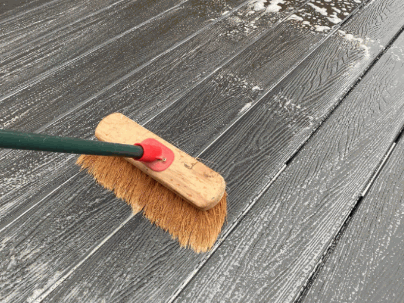
Using a mild cleaning solution is an excellent alternative to pressure washing for maintaining composite decking, as it minimizes the risk of damage while effectively cleaning surfaces. Homeowners should not overlook the importance of gentle yet effective cleaning methods that can enhance the longevity and aesthetic appeal of their outdoor spaces.
For those who prefer DIY solutions, a mixture of equal parts vinegar and water can be an effective mold stain remover. A paste made from baking soda and water can gently scrub away stubborn spots without scratching the surface. For a more robust commercial option, look for eco-friendly cleaners specifically formulated for composite materials.
By routinely applying these mild solutions, homeowners can effectively lift grime and keep their composite decking looking new while safeguarding its integrity. It's also useful to know that maximum PSI for gentle cleaning should not exceed recommended levels to prevent damage.
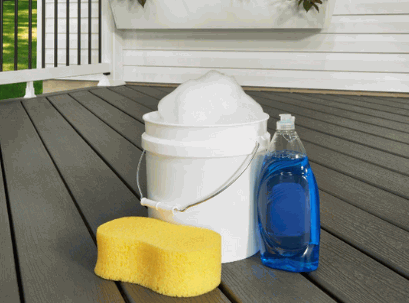
Hiring a professional cleaning service can be a valuable investment for homeowners looking to maintain their composite decking, as experts possess the right tools and knowledge to perform thorough deck maintenance. These services often utilize specialized cleaning solutions and techniques designed for composite materials, ensuring effective mold removal and surface preservation. By employing professionals, homeowners can enjoy peace of mind knowing that their decks are being cared for by experienced individuals who understand the nuances of composite decking.
Along with ensuring effective upkeep, these services help to prevent potential damage that can arise from improper cleaning methods, which can significantly extend the life of the decking. Engaging a service that employs chlorine bleach or UltraBan ensures thorough mold removal and cleaning.
When selecting a cleaning service, consider the following key factors:
By prioritizing these elements, homeowners can secure a trustworthy service, such as those offered by Trex and TimberTech, that not only alleviates their workload but also maintains the beauty and functionality of their decking long-term.